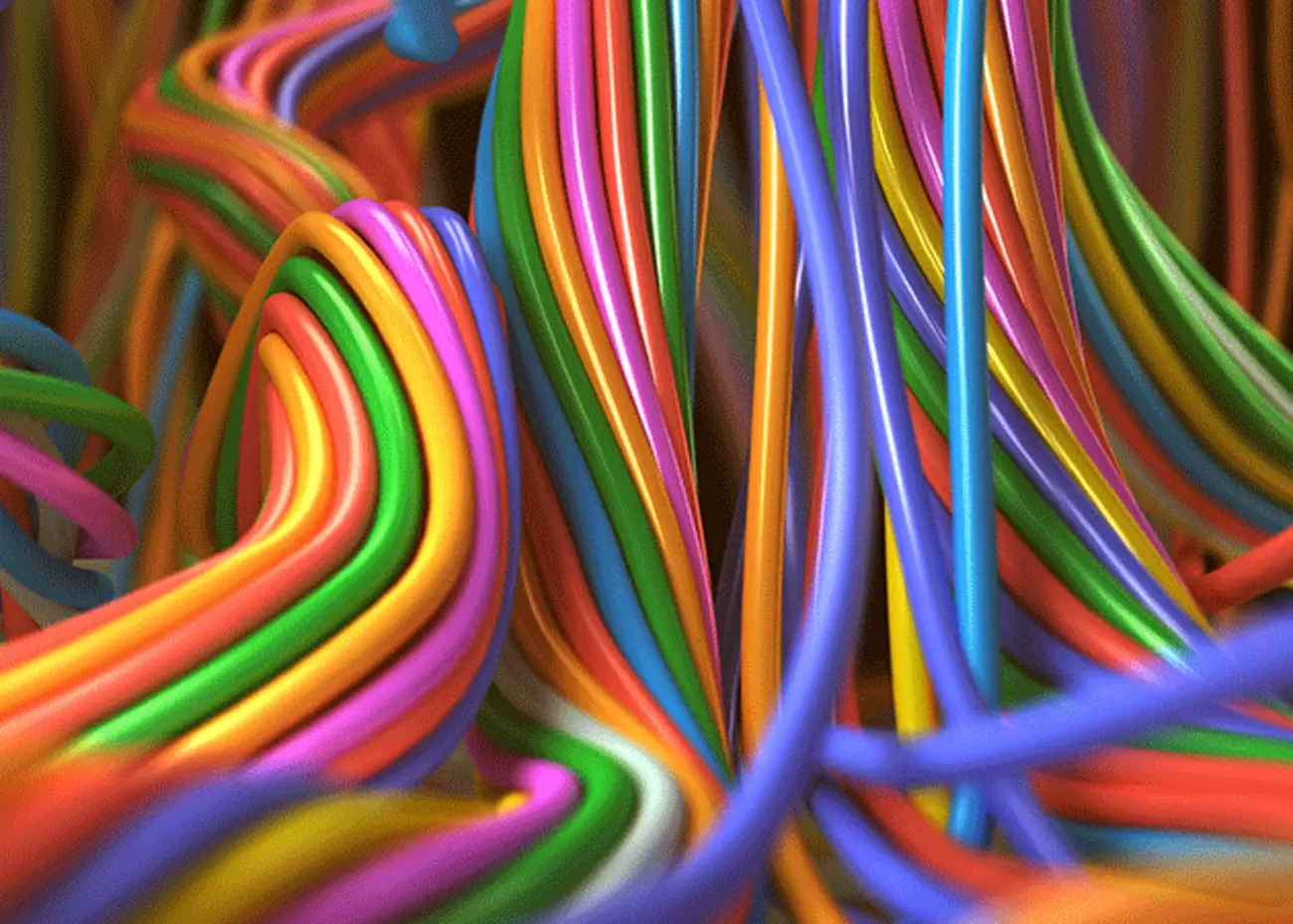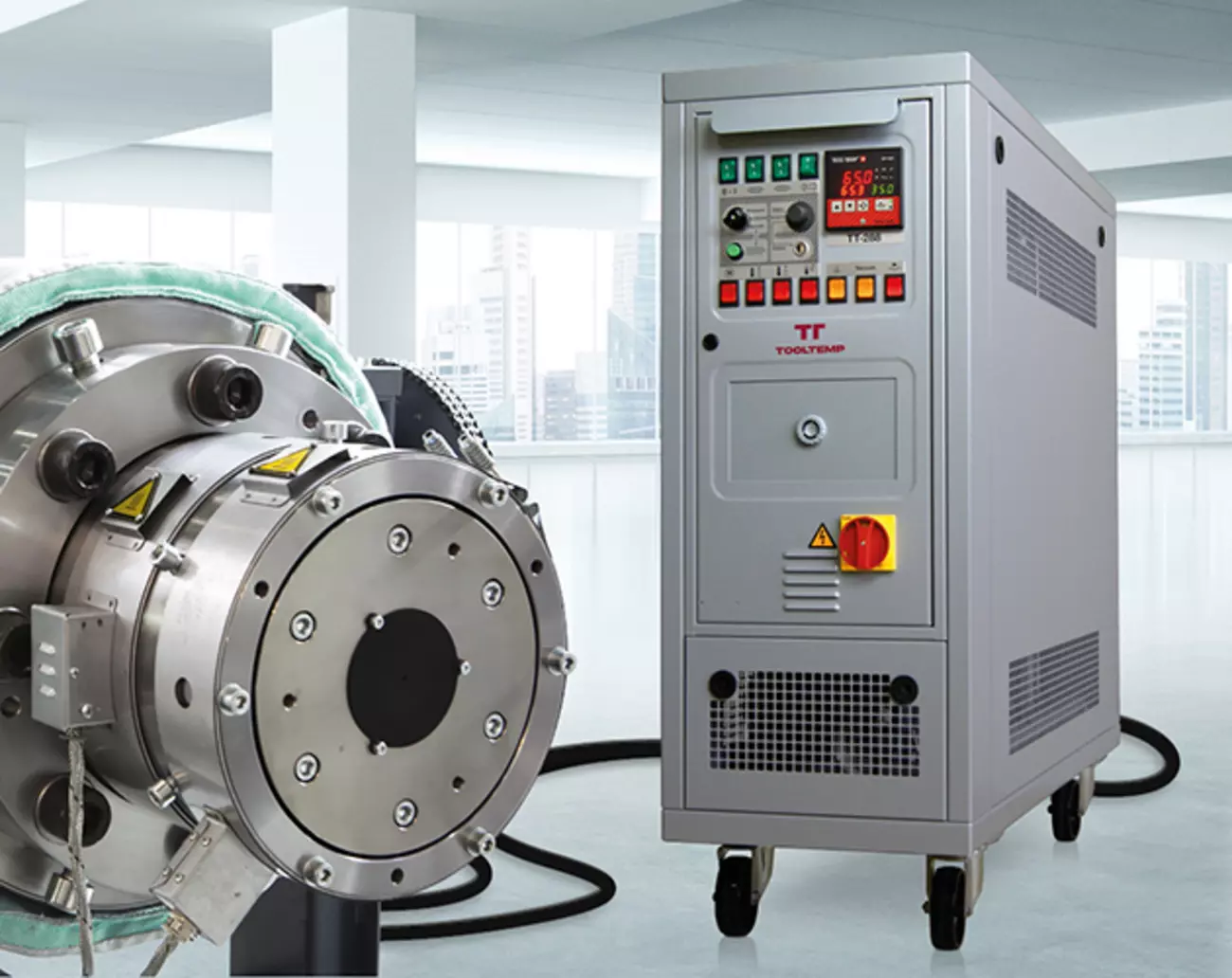Extrusion
Zone temperature control: Efficient temperature control with Tool-Temp devices
When it comes to extrusion, precise temperature control plays a crucial role throughout the entire processing process. We support you in designing the right temperature control unit for your production processes.
Tool-Temp's temperature control and cooling devices optimize and control the temperature in process steps such as melting, compounding, homogenizing, conditioning and discharging, which must be raised or lowered in zones depending on the product and manufacturing process.
Temperature control with liquid heat transfer media offers clear advantages here. In addition to a homogeneous temperature distribution, this regulates the simultaneous supply and removal of heat within a temperature control zone. Precise and responsive temperature control improves the structure of the conveyed mass and helps to achieve an optimal surface quality. The resulting improved conveying behavior enables higher throughputs with consistent quality and increased energy efficiency.
In order to meet the ever-increasing market requirements for manufacturing and quality in extrusion processes, we offer a wide range of powerful, responsive and precise temperature control devices.

Tool-Temp temperature control devices in extrusion processes
Robust, durable, designed for 24/7 operation: temperature control devices for the right use in your extrusion process.
Tool-Temp products are developed and manufactured exclusively in Switzerland. Great attention is paid to the selection of high-quality device components right from the development stage. All parts that come into contact with water are made of stainless steel or bronze. Tool-Temp does not use flexible connections on all devices and deliberately uses robust piping.
All devices use the latest technology to regulate to a tenth of a degree and have an integrated flow measurement, which allows the medium circulation to be monitored at any time.
Tool-Temp has a high level of vertical integration, which ensures consistent quality assurance. Important components such as pumps, heat exchangers, flow meters as well as special switches and relays are produced in the Sulgen factory.
Short response times for customer-specific solutions are a matter of course for us and are part of the service. We take care of optimal temperature control so that you can concentrate on your extrusion production processes.

Extrusion – Efficient temperature control with tool temp
Definition extrusion
Extrusion describes the process in which conveying devices (extruders) use the functional principle of the Archimedean screw to press a solid to viscous mass evenly out of a shaping opening under high pressure and high temperature. This creates bodies with the cross section of the opening, called extrudate, of theoretically any length. We support you in these complex processes with our temperature control devices for optimal temperature control.
Structure and function of an extruder
Basically, an extruder consists of a screw shaft, which is located in a screw barrel and whose inner diameter approximately corresponds to the outer diameter of the screw. At the front end of the cylinder there is an exhaust opening called a nozzle. The screw is mounted at the rear end of the screw barrel. This is where the drive is located, which in most cases consists of an electric motor and a gear unit. This extruder gear is responsible for the rotation of the screw shaft. In most cases, the material to be processed is continuously fed into the cylinder via an overhead hopper. If the material consists of several components, it is important that the composition of the mixture is dosed precisely and reproducibly. Depending on the control mechanism used, a distinction is made between gravimetric and volumetric dosing.
If additional components are required for extrusion, these can be introduced into the screw barrel via needle valves or a side feed, for example - this is known as coextrusion. In plastics processing, these materials can be, for example, colorants (masterbatches), anti-aging agents, plasticizers or reinforcing fibers.
Temperature control of an extruder – with a process thermostat from Tool-Temp
Extrusion process – well supported in temperature control with temperature control devices from Tool-Temp
An extruder can take on a variety of tasks. It can be used for mixing, compacting, blending, degassing and granulating the mass. Depending on the base material and the desired end product, different construction methods are used. A distinction is made between piston, screw, twin screw and planetary roller extruders.
Extrusion using an extruder is a versatile process for processing elastomers and thermoplastics, but also food and animal feed.
Extrusion has developed into an important process engineering element in the plastics and food industries, as well as in the area of recycling. The resulting extrusion products are very diverse. Pipes, rods, window frame profiles, seals and hoses are products that are manufactured using extrusion. But semi-finished products, panels for further processing through thermoforming, foils, polystyrene rigid foam panels, small car parts and bicycle rims are also part of the wide product range, as are pasta, snacks, biscuits, shaped meat and pet food.
Due to the various properties of the processed material, numerous processes have been established in processing technology. Extruders can basically be divided into processing and preparation extruders. Processing extruders, very often single-screw extruders, are mainly used for shaping. On the other hand, there is the processing extruder, which is used to chemically and/or physically modify the materials. The majority of twin-screw extruders and kneaders are used here.
- Cold extrusion
Low pressures, low temperatures and shear forces - Hot extrusion
Lower pressures, higher temperatures - Hot extrusion
High pressures and high temperatures - Coextrusion
Bringing together similar or different materials before leaving the profile nozzle. A distinction is made between one-stage and two-stage processes.
A. Plastics industry & plastics processing
With the temperature control systems from Tool-Temp, you can use proven and robust technology for your production process in the area of extrusion. We are happy to pass on our many years of experience and develop customer-specific solutions for you in order to obtain temperature control tailored to the process.
Extrusion can be used to produce seamless panels, pipes and profiles with a constant cross-section. In addition to the production of extruded semi-finished products, the main area of application for extruders is as a preliminary stage in the injection molding process.
When extruding plastic, heating bands are attached to the screw barrel of the extruder, which melt the filled plastic granules or powder. Depending on the plastic being processed, equipment for pumping out gases is also necessary to avoid bubbles in the end product. Not only do extruders have to be heated, some process engineering tasks also require cooling of the plasticized plastic. This is done either by cooling fans or by cooling channels built into the cylinder, through which a cooling medium flows. In general, thermoplastics and thermoplastic elastomers are extruded. Duroplasts are only processed in the extruder in special cases. Various procedures can be used:
Sheet extrusion
The plasticized mass is pressed through a wide slot die and then smoothed on a gradually heated three-roll mill and brought to the correct thickness. After cooling, the product is cut into panels.
Pipe and profile extrusion
With this extrusion mold, the plasticized mass is pressed through a ring or profile die, calibrated and cooled. When extruding pipes or profiles, the extruded material must be cooled in a calibration table so that it does not deform. The heart of the calibration table is the calibration sleeve, which primarily serves to maintain the shape of the pipe or profile. It is attached directly behind the extruder nozzle and consists of a metal block that has exactly the cross section of the pipe or profile on the inside. Hollow profiles are calibrated using supporting air or vacuum. The extruded tube or profile runs through the calibration sleeve. To maintain the shape of the profile, support air or vacuum is used inside the sleeve. Vacuum openings at different points in the sleeve along the cross section suck the profile onto the inner walls, water flows around and through the profile until it cools down. The type and shape of the calibration table depends very much on the plastic product to be extruded. Especially with complicated profiles, such as window frames, a lot of know-how is required to ensure that the profile does not collapse and deform when it cools down.
Film extrusion
The plasticized mass is pressed through a narrow slot die and drawn off via cooling rollers and stretched by an appropriate rolling mill. With this process, films with a thickness of 8-15 µm and a width of up to 4 m can be produced.
Extrusion blow molding
Extruders are also part of blown film systems. Here the plasticized material is not shaped into a profile, but rather inflated into a wafer-thin film bubble. For this purpose, the melt is deflected in a vertical direction and shaped into a hose using spiral distributor tools. By arranging up to nine extruders in a ring and combining the individual melt streams in the spiral distributor tool, multi-layer films can be produced in this way. In order to bring the emerging melt tube to the usual thickness of several hundredths of a millimeter, the tubes are then stretched in the longitudinal and transverse directions. This is done by centrally blowing in air, which not only stretches the tube mechanically, but also cools it down and thus fixes it in its shape. The film tube is calibrated, folded over and wound up using a basket.
Hollow body bubbles
The plasticized mass is formed into a tube through a ring nozzle. The still plastic hose is clamped through a two-part mold and inflated in the mold with compressed air. The hose fits tightly to the mold and the blown part is ejected after it has cooled down. This process is used to produce hollow objects such as tubes, bottles, canisters, barrels, etc.
B. Food industry – temperature control and cooling of food
The actual heart of many food and feed production processes is extrusion. Here we support you with the right devices. In addition to the plastics industry, the food industry is the main customer for extruders. Extruders knead, mix, cook and portion foods such as cereals, cornflakes, textured proteins, vitaminized rice, and pasta. To ensure that the products remain consistent in terms of quality, consistency and taste, precise and reproducible temperature control is necessary. A cooking process must always be carried out precisely. This usually involves switching between different recipes. During hot extrusion, a water-containing mass is heated under high pressure in a compression screw. The pressure drops at the outlet nozzle and the product is loosened significantly. The already gelatinized starch can support gas retention and hold on to tight pores. Typical products of this process are peanut chips, snack items, breads and pastries.
C. Rubber industry
Rubber extrusion is a forming process in which synthetic or natural rubber granules are pressed through a tool mold using the hot extrusion process to produce profiles, sealing material, mats, etc.
D. Recycling
Special single or twin screw extruders are used to recycle clean and pure plastic waste into recyclates (starting material for new plastic products). In order to achieve the high quality standards in this recycling process, polymer purity is of great importance. To ensure that as many contaminants as possible are captured in plastic recycling, separation occurs in the melt stream between the conveyor machine (extruder) and the extrusion tool. Various separation techniques are often used in advance to achieve varietal purity. During extrusion, the properties of the plastics can be improved by adding additives.
Contact now
How can we help you?